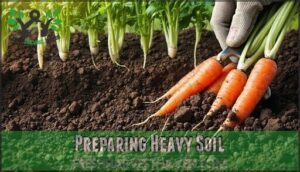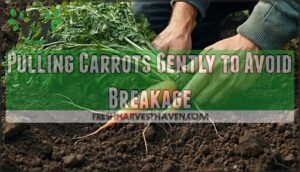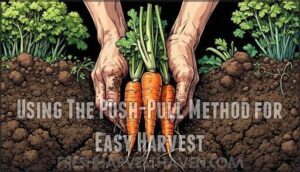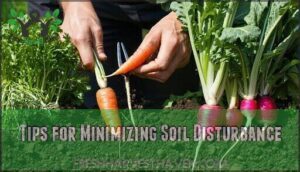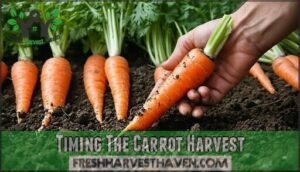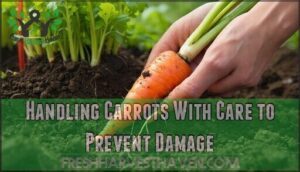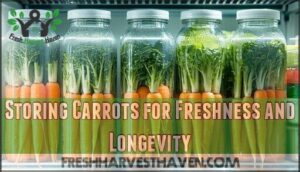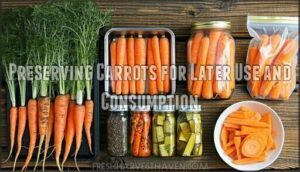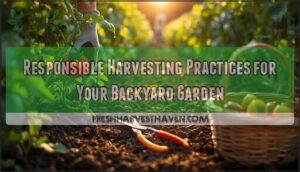This site is supported by our readers. We may earn a commission, at no cost to you, if you purchase through links.
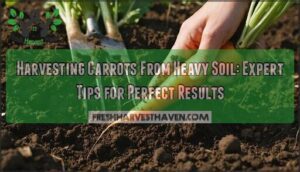
You’ll need to loosen the soil around each carrot first—use a garden fork to gently work 6-8 inches deep alongside the row.
Water the area thoroughly an hour before harvest to soften clay soil.
Grasp carrots close to the crown and pull straight up with steady pressure, avoiding twisting motions that snap roots.
For stubborn carrots, wiggle slightly while maintaining upward tension.
The secret lies in preparing your soil properly and timing your harvest when conditions are just right.
Table Of Contents
- Key Takeaways
- Harvesting Carrot Basics
- Preparing Heavy Soil
- Harvesting Techniques
- Timing The Carrot Harvest
- Post-Harvest Carrot Care
- Frequently Asked Questions (FAQs)
- Can carrots grow in hard soil?
- How to loosen soil for carrots?
- Can you leave carrots in the ground too long?
- Can I harvest carrots after rainfall?
- When is too cold to harvest carrots?
- How do I clean muddy harvested carrots?
- Can companion plants help with harvest?
- Will carrots regrow after partial harvest?
- What tools work best for harvesting in clay?
- How do I prevent carrot splitting during harvest?
- Conclusion
Key Takeaways
- Water the soil an hour before harvest – this softens heavy clay and makes extraction much easier without breaking roots
- Use a garden fork to loosen soil 6-8 inches deep alongside carrot rows before pulling to break up compacted earth around each root
- Pull straight up with steady pressure while grasping carrots close to the crown – avoid twisting motions that’ll snap the roots in dense soil
- Time your harvest for cool, dry conditions between 60-70°F when soil moisture is just right – not waterlogged but not bone dry either
Harvesting Carrot Basics
Heavy clay soil can make carrots grow short and stubby, but don’t let that stop you from growing these sweet orange gems.
Understanding how soil density affects carrot development and using the right harvesting techniques will help you pull perfect carrots from even the toughest ground, which is crucial for growing sweet orange gems like carrots.
Carrot Growth in Heavy Soil
The challenge of carrot harvesting becomes amplified when you’re dealing with heavy soil conditions that resist cooperation.
Soil compaction creates a fortress around developing roots, forcing carrots to grow stunted or misshapen as they struggle against dense earth.
- Heavy soil restricts root development, causing carrots to fork or become stubby instead of achieving their characteristic tapered shape
- Water retention increases in compacted conditions, potentially leading to rot or splitting during the growing season
- Nutrient uptake suffers when roots can’t penetrate effectively, resulting in smaller, less flavorful carrots that require different harvesting techniques
Adding amendments like composted manure can improve soil structure.
This is because organic matter is essential for aeration.
Effects of Soil Density on Carrots
Dense soil creates three major obstacles for your carrots.
Heavy clay doesn’t have to mean stubby carrots—with the right approach, you can still harvest garden gold.
First, soil compaction restricts root development, forcing carrots to grow shorter and stubbier rather than long and straight.
Second, compacted heavy soil limits nutrient uptake and water retention, stunting carrot size and overall health.
Importance of Proper Harvesting Techniques
Heavy soil carrots face unique harvesting challenges that require careful technique.
Using proper harvesting methods will minimize damage to your crop while maintaining quality.
When you harvest carelessly, you’ll reduce yield and extend the time needed for carrot care.
Smart harvesting techniques improve yield by preventing breakage from soil compaction, helping you reduce waste and extend freshness of your harvest, with proper harvesting methods, smart harvesting techniques, and careful technique being crucial.
Preparing Heavy Soil
Heavy soil creates unique challenges when harvesting carrots, but proper preparation makes all the difference.
You’ll need to loosen the compacted earth and improve its structure before attempting to pull your crop.
Loosening Soil With Forks and Tools
Before harvesting carrots from heavy soil, you’ll need to loosen the compacted earth around your plants.
Garden tools like broadforks and digging forks work best for this task. The key is working systematically without damaging the delicate carrot roots below.
Here are five effective forking techniques for loosening heavy soil carrots:
- Insert your fork 6 inches away from carrot rows to avoid piercing roots during soil aeration
- Rock the fork back and forth rather than lifting to create efficient loosening without disturbing soil structure
- Work in a grid pattern across your carrot bed for consistent soil amendment coverage
- Use a broadfork for larger areas – this tool selection provides better leverage in dense soil
- Keep fork tines angled outward to prevent root damage while breaking up compacted layers
Fall is also a great time to think about adding organic matter to your garden.
Strategies for Improving Soil Structure
Improving soil structure requires a multifaceted approach beyond simple tool work.
Apply gypsum at 20-40 pounds per 1,000 square feet to promote clay particle aggregation and enhance drainage solutions.
Deep-rooted cover cropping with radishes or winter peas creates natural channels while adding organic matter. Reduced tillage practices prevent further compaction, allowing beneficial microbes to establish.
Strategic soil amendment timing—avoiding wet conditions—preserves structural improvements you’ve worked to achieve in your carrot cultivation efforts. To further improve soil conditions, consider ways to enhance organic matter and adopt a reduced tillage practice for better results with beneficial microbes and organic matter.
Using Organic Matter to Enhance Soil
Working organic matter into heavy soil transforms it from stubborn clay into a carrot-friendly growing medium.
Compost benefits include improved drainage and soil structure, while manure application adds essential nutrients.
Green manures and cover cropping between seasons build soil organic matter naturally, creating the perfect foundation for successful carrot cultivation in organic gardening systems, which rely on these soil amendments to produce a healthy crop with improved drainage.
Harvesting Techniques
When harvesting carrots from heavy soil, you’ll need specific techniques to extract them without damage or breakage.
The key is working with the soil’s density rather than fighting against it, using gentle methods that preserve both your carrots and the surrounding soil structure, which is crucial for maintaining soil health.
Pulling Carrots Gently to Avoid Breakage
Gentle pulling requires finesse when harvesting carrots from dense earth.
Position your hands close to the carrot’s base, ensuring proper hand placement for root support.
Check soil moisture first – slightly damp conditions prevent avoiding snapping during extraction.
Grasp the green tops firmly while supporting the orange root with your other hand.
Pull steadily upward without twisting motions that cause breakage in challenging soil types, requiring proper hand placement.
Using The Push-Pull Method for Easy Harvest
When dealing with stubborn carrots in compacted earth, mastering Push-Pull Mechanics transforms your harvesting experience.
This technique creates Soil Leverage Points that reduce Carrot Resistance Factors substantially. You’ll gently push the carrot down first, then pull upward, breaking the soil’s grip while Minimizing Carrot Damage through strategic motion.
The process can be aided by various loosening tools to prepare the soil.
- Optimal Hand Placement: Grip carrots close to the soil surface, keeping fingers positioned for maximum control during the push-pull sequence
- Soil Leverage Points: Create mechanical advantage by using downward pressure to fracture compacted layers before extraction
- Carrot Resistance Factors: Reduce breakage rates by up to 45% compared to direct pulling methods in heavy soil types
Tips for Minimizing Soil Disturbance
Watering before harvesting softens heavy soil, making carrot extraction easier without damaging roots.
Use gentle tools like hand forks to carefully lift carrots from loosened earth. Companion planting with radishes helps break up compacted areas naturally.
Raised beds improve soil conditions dramatically, reducing disturbance during harvest. Consider harvesting after a frost to enhance sweetness.
Focus on careful lifting techniques that preserve soil structure for future planting success, using methods like gentle tools and companion planting to ensure a successful harvest with raised beds.
Timing The Carrot Harvest
You’ll get the best carrots by harvesting at the right time, watching for the ideal size and checking the weather.
If you wait too long, carrots can become tough or spoil, so timing is key for a crisp, sweet crop.
Checking Carrot Maturity and Size
Perfect timing means knowing when your carrots reach their peak. You’ll determine harvest readiness through careful observation and testing methods that guarantee superior flavor and texture.
Check these key indicators to confirm your carrots are ready:
- Diameter Measurement – Measure at the shoulder; round varieties should reach 1.5 inches, while longer types need similar width
- Color Assessment – Look for vibrant orange hue with no green shoulders showing above soil line
- Top Condition – Healthy, full foliage indicates active growth; yellowing suggests over-maturity
- Tasting Carrots – Pull a test carrot; sweet flavor and crisp texture confirm readiness across different carrot varieties
Monitoring Weather Conditions for Optimal Harvest
Weather patterns play a vital role in determining harvest success.
Cool, dry conditions between 60-70°F create ideal harvesting scenarios, while temperatures above 90°F trigger bolting and reduce quality.
Monitor rainfall impact carefully—moist soil eases extraction but waterlogged conditions increase breakage in heavy soil texture.
Frost risk enhances sweetness through starch conversion, though hard freezes damage roots.
Check humidity levels and sunlight influence daily, as overcast conditions help preserve carrot freshness during soil moisture management.
Knowing when to harvest guarantees optimal flavor through optimal flavor.
Avoiding Over-Maturity and Carrot Spoilage
Timing matters when harvesting carrots to prevent over-maturity that leads to cracking, tough texture, and bitter taste changes.
Check your carrots regularly once they reach harvestable size—leaving them too long invites pest damage and disease control issues.
Over-mature carrots split, attracting insects and compromising storage impact.
Harvest promptly using proper harvesting methods to maintain quality for your harvesting vegetables goals, and remember that timing matters to avoid issues like pest damage.
Post-Harvest Carrot Care
Once you’ve successfully harvested your carrots from heavy soil, proper post-harvest care becomes essential for maintaining their quality and extending storage life.
The way you handle, clean, and store your freshly pulled carrots directly impacts their flavor, texture, and nutritional value for weeks or even months to come, which is crucial for maintaining their overall quality.
Handling Carrots With Care to Prevent Damage
Anyone can damage freshly harvested carrots if they’re not careful during the vegetable harvesting process. Handle your carrots with gentle handling techniques to prevent cracks and avoid bruising the delicate skin.
Don’t grab multiple carrots at once during harvesting season – this leads to scratches and breaks. Instead, lift each carrot individually, supporting the entire length.
Skip washing carrots immediately after harvesting; brush off excess soil gently for proper storage preparation to ensure the carrots remain in good condition, and use delicate skin care to maintain their quality.
Storing Carrots for Freshness and Longevity
Once you’ve carefully handled your freshly harvested carrots, proper storage becomes your next priority.
Store carrots at 32-38°F with 98-100% humidity levels for ideal freshness. Remove tops before storage and select airtight containers or sealed plastic bags with paper towels.
For best results, consider using specialized food storage. This container selection prevents dehydration and extends storage duration up to 3-4 weeks, preventing spoilage through controlled conditions during harvesting season.
Preserving Carrots for Later Use and Consumption
Several methods extend your carrot harvest well beyond the growing season.
Freezing carrots requires blanching first, while canning carrots preserves them in jars for months.
Pickling carrots creates tangy snacks, and drying carrots concentrates their sweetness.
Carrot fermentation develops complex flavors through beneficial bacteria.
Each preservation method maintains the nutritional value of your freshly harvested garden produce storage investment.
Frequently Asked Questions (FAQs)
Can carrots grow in hard soil?
Carrots can grow in hard soil, but you’ll face challenges.
Dense soil restricts root expansion, leading to stunted, misshapen carrots.
You’ll need to loosen the soil or choose shorter varieties for better results.
How to loosen soil for carrots?
You’ll want to work compost or aged manure into compacted earth before planting.
Use a broadfork to break up hardpan layers without destroying soil structure, then add coarse sand to improve drainage and aeration permanently.
Can you leave carrots in the ground too long?
Prolonged presence produces problems.
You can’t leave carrots indefinitely underground – they’ll become woody, bitter, and crack from continued growth.
Harvest them when they’re sweetest and most tender for maximum flavor.
Can I harvest carrots after rainfall?
Absolutely, you can harvest carrots after rainfall, though you’ll need to wait for the soil to dry slightly first.
Wet, muddy conditions make digging difficult and can damage both carrots and remaining plants, especially in heavy clay soils, where muddy conditions can be particularly problematic.
When is too cold to harvest carrots?
You can harvest carrots down to about 20°F (-7°C).
They’ll actually sweeten as temperatures drop since they convert starches to sugars for freeze protection.
However, once soil freezes solid, digging becomes nearly impossible without tools, and carrots will be difficult to harvest at this point due to the frozen soil.
How do I clean muddy harvested carrots?
Like scrubbing away winter’s stubborn grip, you’ll need patience and the right approach.
Rinse carrots under cool running water, gently scrubbing with a vegetable brush to remove soil without damaging the skin.
Can companion plants help with harvest?
Yes, companion plants can substantially help with harvest.
You’ll find that carrots planted with chives or radishes grow straighter and develop better flavor.
Radishes also break up heavy soil, making carrot harvesting much easier, which is a key benefit of using radishes as companion plants.
Will carrots regrow after partial harvest?
Studies show carrots won’t regrow from their orange roots after you’ve harvested them.
Unlike green leafy vegetables that can bounce back from their base, once you pull that carrot from the ground, it’s done growing for good.
What tools work best for harvesting in clay?
For clay soil, you’ll want a spading fork to loosen compacted earth around carrots.
A narrow trowel helps pry them out gently.
Garden hose water softens clay, making extraction easier without breaking roots, using a spading fork is crucial.
How do I prevent carrot splitting during harvest?
Don’t worry about muddy mess – it’s worth it! Water carrots thoroughly before harvest, loosen soil around them gently, then pull straight up with steady pressure to avoid splitting.
Conclusion
Success stories begin with carrots emerging whole from challenging clay gardens, their orange treasures intact despite the soil’s tight grip.
When you master harvesting carrots from heavy soil, you’ll transform what once felt impossible into a routine garden victory.
Remember that patience and proper technique matter more than force.
Water beforehand, work carefully around each root, and pull steadily upward, and your persistence will reward you with perfect carrots and healthier soil for future seasons.
- https://docs.google.com/forms/d/1GAQr3Kn1cURCVHUA82hAga1Wv8DCH0IuqDLRUrOpN7M/viewform?ts=63f4f653&entry.1515682415=https://www.merriam-webster.com/dictionary%2Fharvest
- https://premium.britannica.com/mw-unabridged/?utm_source=mw&utm_medium=inline-def&utm_campaign=evergreen
- https://www.freethesaurus.com/harvesting
- https://medical-dictionary.thefreedictionary.com/harvesting
- https://idioms.thefreedictionary.com/harvesting

